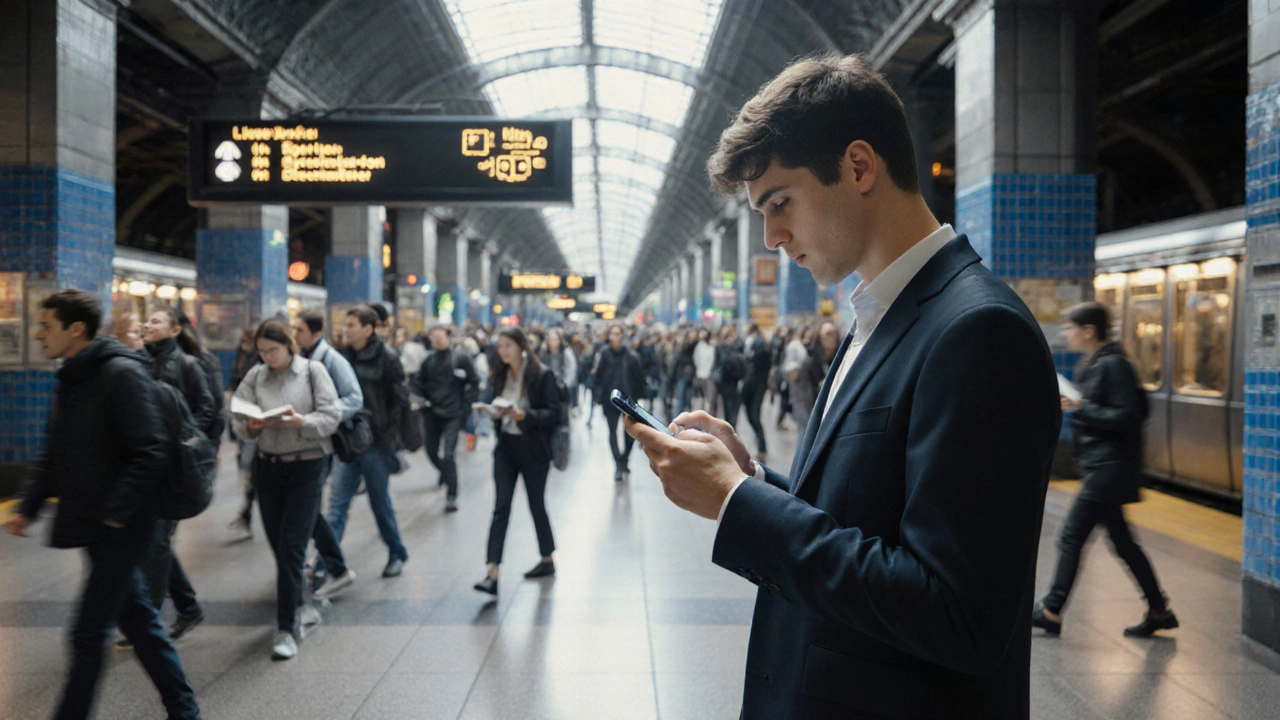Urban Budget Calculator
Calculate your monthly city expenses and discover how to save up to 25% using urban strategies from the article.
Your Monthly Expenses
Enter your current spending for key city expenses
Estimated Savings
Smart Strategies
Living in a bustling metropolis isn’t just about skyscrapers and traffic; it’s a daily boot‑camp that sharpens your mind, finances, and social skills. Big City Life the fast‑paced urban environment that millions call home throws challenges at you that smaller towns rarely do, and each challenge carries a hidden lesson. If you can read those signals, you’ll walk away with a toolbox of habits that any city dweller can use to thrive.
Lesson 1: Master Public Transportation to Save Time and Money
When you first arrive in a major city, the endless maze of subways, buses, and bike‑share stations can feel overwhelming. Public Transportation the network of trains, buses, and shared mobility options that moves millions daily isn’t just a convenience-it’s a lesson in efficiency. Knowing the rush‑hour patterns, fare shortcuts, and real‑time apps can cut commute times by up to 30% and shave hundreds of dollars off monthly travel costs.
- Download the city’s official transit app; it shows live arrivals and service alerts.
- Invest in a reloadable fare card; many systems offer discount tiers for frequent riders.
- Plan routes that combine walking with transit to avoid the most congested lines.
These habits translate to other areas of life: constantly looking for the path of least resistance while still getting the job done.
Lesson 2: Embrace Cultural Diversity for Creative Thinking
The city’s population is a mosaic of languages, cuisines, and traditions. Cultural Diversity the presence of multiple ethnic and cultural groups within a shared urban space forces you to question assumptions and see problems from fresh angles. By regularly attending neighborhood festivals, trying a new restaurant each week, or simply striking up conversations on the subway, you train your brain to think laterally.
Research from the University of Chicago showed that teams with higher cultural heterogeneity generated 25% more innovative ideas than homogenous groups. That’s a direct payoff you can reap in your career, hobbies, or even personal relationships.
Lesson 3: Build a Strong Network Using the City’s Social Hotspots
Unlike quiet towns where everyone knows everyone, big cities demand proactive networking. Networking the process of creating and maintaining professional or personal connections becomes a skill you refine at co‑working spaces, industry meet‑ups, and even coffee‑shop power‑hours.
- Identify three recurring events in your field (e.g., monthly tech talks, design brunches, startup pitch nights).
- Set a goal to attend at least one per month and exchange contact info with two new people.
- Follow up within 48hours with a personalized message referencing your conversation.
Over a year, this habit can grow your LinkedIn connections by several hundred, opening doors to jobs, collaborations, and mentorship that would be impossible in a smaller community.
Lesson 4: Hone Time Management Skills Amid Endless Distractions
The city never sleeps, and neither do its notifications. From pop‑up ads to street performers, the environment constantly tests your focus. Time Management the ability to allocate time effectively to achieve goals becomes a survival trait.
Try the “two‑minute rule”: if a task takes less than two minutes-replying to a quick email, ordering a coffee, or sorting a receipt-do it immediately. For larger projects, block off “deep‑work” windows on your calendar and treat them like non‑negotiable meetings.
City dwellers who master this skill report a 20% boost in productivity and a noticeable drop in stress levels.

Lesson 5: Strengthen Financial Literacy to Handle Higher Costs
Rent, groceries, and entertainment all come with city‑premium price tags. Financial Literacy the knowledge and skills to manage money effectively is no longer optional-it’s a daily requirement.
| Expense | Average Monthly Cost | Smart Strategy |
|---|---|---|
| Rent (1‑bedroom downtown) | $2,500 | Roommate sharing or sub‑letting unused space |
| Groceries | $400 | Shop at local markets; bulk‑buy staples |
| Transit Pass | $130 | Off‑peak passes; bike‑share integration |
| Entertainment | $250 | Free museum nights; community events |
By tracking every expense for a month, you can spot patterns, negotiate better deals, and set realistic savings goals-an essential habit that keeps you from living paycheck‑to‑paycheck despite high salaries.
Lesson 6: Prioritize Stress Management in a High‑Pressure Environment
Constant noise, crowds, and deadlines can wear you down. Stress Management the practice of controlling stress levels through mental and physical techniques becomes a daily routine.
Simple actions like taking a five‑minute walk in a nearby park, using a meditation app during a commute, or joining a weekend yoga class can lower cortisol by up to 15%. The key is to treat self‑care as a scheduled appointment, not an after‑thought.
Lesson 7: Leverage Community Events for Belonging
Even though cities feel anonymous, they also host countless micro‑communities-farmers’ markets, street art tours, tech hackathons, and neighborhood clean‑ups. Participating in these events builds a sense of belonging that counters the "lonely in a crowd" feeling.
Pick one event each month that aligns with an interest you want to explore. Over time, you’ll recognize familiar faces, gain insider tips, and perhaps even discover a new hobby that enriches your urban life.
Lesson 8: Adapt to Gentrification and Urban Change
Neighborhoods evolve-old warehouses become lofts, and boutique cafés replace mom‑and‑pop shops. Understanding gentrification helps you stay ahead of rent spikes and cultural shifts. Keep an eye on city planning meetings, follow local news, and be ready to relocate to emerging districts before prices soar.
This proactive mindset not only saves money but also gives you the chance to be part of a community’s early growth, fostering a sense of ownership and influence.
Putting It All Together: Your Personal Urban Survival Checklist
- Transit Savvy: Master the city’s transit app, buy a reloadable card, plan alternate routes.
- Cultural Curiosity: Attend at least one cultural event per month.
- Network Routine: Join a co‑working space or meetup, exchange contacts, follow up.
- Time Guard: Block deep‑work periods, apply the two‑minute rule.
- Finance Tracker: Log all expenses for 30 days, identify three cost‑saving actions.
- Stress Reset: Schedule a weekly 15‑minute mindfulness break.
- Community Participation: Sign up for a local event calendar.
- Neighborhood Scout: Review city council minutes quarterly for upcoming changes.
Following this checklist isn’t a rigid rulebook; it’s a flexible framework that lets you extract the most value from the whirlwind that is big city life lessons. As you practice each habit, you’ll notice a smoother commute, stronger friendships, a healthier bank account, and a calmer mind-proof that the city is really a teacher, not a foe.
Frequently Asked Questions
How can I budget effectively in a high‑cost city?
Start by tracking every dollar for a month using a spreadsheet or budgeting app. Identify categories where you spend more than 30% of your income (usually rent, groceries, and transit). Swap expensive habits-cook at home, use public transit passes, and consider roommate sharing. Set a realistic savings target (e.g., 10% of net income) and automate transfers to a separate account each payday.
What are the best ways to meet people when I move to a new city?
Leverage co‑working spaces, industry meet‑ups, and hobby‑based clubs (e.g., running groups or book clubs). Attend free community events listed on city websites or apps like Meetup. When you’re at a coffee shop, sit at the communal table and start a conversation about the space or the weather. Consistency is key-show up regularly and follow up with contacts you meet.
How do I avoid burnout from the constant city hustle?
Schedule daily “unplugged” moments-walk in a park, practice meditation, or read a physical book. Keep work boundaries: turn off email notifications after office hours and set a firm bedtime. Engage in a weekly hobby that isn’t connected to your job, like a cooking class or a sports league, to recharge your mental energy.
Is public transportation always the cheapest option?
Most of the time, yes-especially when you factor in parking fees, fuel, and vehicle maintenance. However, compare monthly transit passes with ride‑share discounts and bike‑share memberships for your specific travel patterns. In some cities, a combination of bike‑share for short trips and transit for longer commutes yields the best cost‑benefit ratio.
What should I look for when choosing a neighborhood to live in?
Consider walkability scores, proximity to work or transit hubs, safety statistics, and the presence of amenities like grocery stores, parks, and community centers. Also, research any upcoming zoning changes that could affect rent prices. Visiting the area at different times of day helps you gauge noise levels and overall vibe.


Write a comment